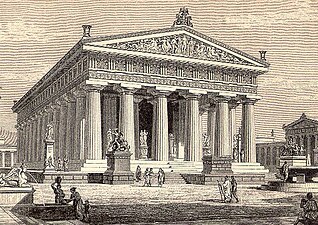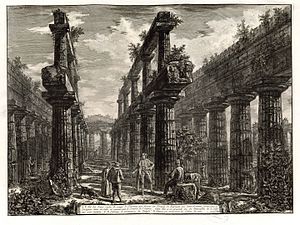Second Temple of Hera (Paestum)
| Second Temple of Hera (Paestum) | |
|---|---|
 Second temple of Hera | |
 | |
| General information | |
| Location | Paestum, Campania |
| Completed | c. 450 BC |
Cilento and Vallo di Diano National Park with the Archeological Sites of Paestum and Velia, and the Certosa di Padula | |
| Criteria | Cultural: (iii), (iv) |
| Reference | 842-001 |
| Inscription | 1998 (22nd Session) |
The Temple of Hera II (also erroneously called the Temple of Neptune or of Poseidon), is a
The name "Temple of Neptune" is a misnomer from the 18th century, it is now thought it was actually dedicated to the goddess Hera, although it is possible that Poseidon (Neptune to the Romans) was also a dedicatee.
Description

The temple measures 24.46 by 59.98 metres, with six external columns along its shorter sides and fourteen columns along its longer sides (counting the corner columns twice).[2] These are 8.88 metres high (29 feet), and the columns at the ends taper from a diameter of nearly 7 feet at the bottom to about 5 feet at the top; the columns on the sides taper by less. This gives a ratio of height to lower diameter of 4.25:1, unusually low for the period.[3]
Instead of the 20 flutes normal for Doric order column by this date, the large external columns have 24 flutes, the smaller lower columns in the cella 20, and the still smaller upper ones on the architraves 16.[4] The Temple of Hera II also has a wider column size and smaller intervals between columns. The entasis, or curve, of its columns give a stronger visual presence. This temple is aligned with a double peaked mountain considered to be sacred by the Greeks.
The temple was also used to worship Zeus and another deity, whose identity is unknown. There are visible on the east side the remains of two altars, one large and one smaller. The smaller one is a Roman addition, built when a road leading to a Roman forum was cut through the larger one.
It also is possible that the temple originally was dedicated to both Hera and Poseidon; some offertory statues found around the larger altar are thought to demonstrate this identification.
The Temple of Hera II resembles the Temple of Zeus at Olympia, of the same period.[5] With the other temples at Paestum it is one of the best preserved early Greek temples.
Gallery
-
Across the cella
-
the First and Second Hera temples, the ruins of the city centre, and the Temple of Athena in the distance
-
The archaeological area around
-
Reconstruction of the second temple of Hera fromPierer'sUniversal-Lexikon, 1891.
-
Etching by Giovanni Battista Piranesi, 1778
Notes
References
- Lawrence, A. W., Greek Architecture, 1957, Penguin, Pelican history of art
- Temple of Hera II, archaic Doric temple, 470–460 BCE








